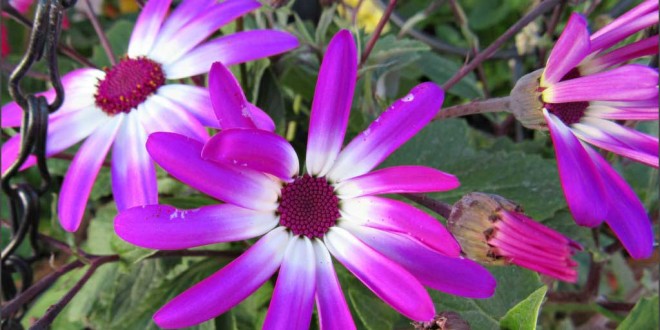Prior to this spring (2016), I had not seen this daisy-like flower. In vivid blues, magic magentas, ultraviolets and stunning bicolors, where else can you find vibrant color early in the season? Plant Senetti with other cool companion bedding plants in early spring, such as pansies. Senetti thrives in full sun and partial sun conditions and down to 35 degrees.
Pericallis is a small genus of about 14 species of flowering plants in the family Asteraceae, native to the Canary Islands and Madeira. The genus includes herbaceous plants and small subshrubs.
Bred by Suntory Flowers in Japan, Senetti is a collection of pericallis hybrids, which were obtained by cross breeding members of the Compositae and Asteraceae familes. Before reclassification, Senetti was known as a cineraria hybrid, but Senettis are nothing like seed-grown cineraria grown as a house plant. Their large, daisylike flowers bloom from early spring until summer. Bloom count can be as high as 200 on a plant grown in a 10-inch pot. Senetti also has a unique reblooming ability. Cut plants back 50 percent for a fresh flush of blooms. Plants will stop flowering when temperatures are 80 degrees are higher at night during the summer. Senetti is an early spring plant and likes cool weather.
All parts of the Cineraria are toxic and can be fatal to equines. Lucky for me there are no horses on my street.
Read more: http://www.finegardening.com/senetti-pericallis-senetti#ixzz41JMOoyAH
Follow us: @finegardening on Twitter | FineGardeningMagazine on Facebook
Bloom Characteristics:
Water Requirements:
Requires consistently moist soil; do not let dry out between waterings
Where to Grow:
Height:
12-18 in. (30-45 cm)
18-24 in. (45-60 cm)
24-36 in. (60-90 cm)
Spacing:
12-15 ft. (3.6-4.7 m)
Hardiness:
USDA Zone 10a: to -1.1 °C (30 °F)
USDA Zone 10b: to 1.7 °C (35 °F)
Sun Exposure:
Danger:
Bloom Color:
Magenta (Pink-Purple)
Red
Light Blue
Dark Blue
Purple
White/Near White
Bloom Time:
Mid Spring
Late Spring/Early Summer
Foliage:
Velvet/Fuzzy-Textured
Veined
Other details:
Soil pH requirements:
6.6 to 7.5 (neutral)
7.6 to 7.8 (mildly alkaline)
Patent Information:
Propagation Methods:
Self-sows freely; deadhead if you do not want volunteer seedlings next season
Seed Collecting:
Allow seedheads to dry on plants; remove and collect seeds
Regional:
Alameda, California
Amesti, California
Atherton, California
Castro Valley, California
Citrus Heights, California
Read more: http://davesgarden.com/guides/pf/go/54084/#ixzz41JNWKVP4








